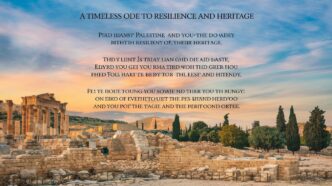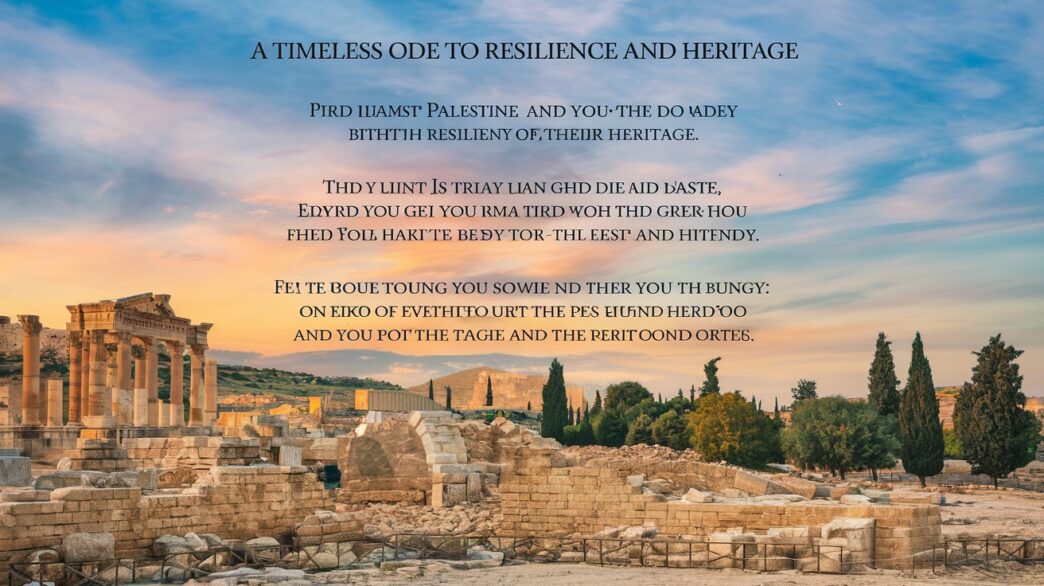The “Palestine Sonnet Poem” captures the essence of a land rich in history, culture, and emotional significance. Through the lens of poetry, particularly the sonnet—a timeless and elegant form—we explore the story of Palestine, its struggles, its beauty, and the hope that endures through generations. This article delves into the essence of the “Palestine Sonnet Poem,” its themes, structure, and significance in the broader context of Palestinian identity and expression.
What is a Palestine Sonnet Poem?
A Palestine Sonnet Poem is a poetic creation that combines the structure of a traditional sonnet with themes central to the Palestinian experience. Sonnets, consisting of 14 lines with a specific rhyme scheme, have historically been used to express love, loss, and profound emotions.
When applied to Palestine, this poetic form takes on a new dimension, addressing themes such as resilience, cultural heritage, and the longing for peace. The structured elegance of the sonnet mirrors the enduring spirit of Palestine, while its lyrical quality evokes the deep emotions tied to the land and its people.
Themes of the Palestine Sonnet Poem
The “Palestine Sonnet Poem” weaves together several powerful themes:
- Heritage and Identity: Palestine’s rich history, symbolized by olive trees, ancient ruins, and sacred sites, forms a central theme. The sonnet often celebrates the enduring cultural identity that has persisted through centuries of change and conflict.
- Pain and Struggle: The challenges faced by Palestine and its people are poignantly expressed in the sonnet. The imagery of tears, conflict, and loss serves to highlight the hardships while paying homage to the resilience of those who endure.
- Hope and Renewal: Despite the pain, the sonnet frequently concludes with a message of hope—a yearning for peace and a brighter future. This optimism reflects the unyielding spirit of Palestine.
Why Use a Sonnet for Palestine?
The sonnet form, with its structured beauty and emotional depth, is a fitting choice for exploring the story of Palestine. Its strict format—14 lines with a specific rhyme and meter—symbolizes order and resilience amidst chaos, much like the Palestinian spirit.
Additionally, sonnets allow for the exploration of contrasting ideas, such as pain and hope or destruction and renewal, making it an ideal medium for capturing the complexity of Palestine’s narrative.
Symbolism in the Palestine Sonnet Poem
The “Palestine Sonnet Poem” is rich in symbolism, drawing on cultural and natural elements unique to the region:
- Olive Trees: As a recurring motif, olive trees symbolize peace, endurance, and sustenance. Their roots mirror the deep connection of the Palestinian people to their land.
- Hills and Stones: The landscape of Palestine, with its ancient hills and stone-built villages, represents timelessness and resilience. These elements often feature in sonnets to convey a sense of permanence.
- Tears and Rivers: The imagery of water—whether as tears of sorrow or rivers of hope—serves as a metaphor for the emotional and spiritual journey of Palestine.
How the Palestine Sonnet Poem Reflects Cultural Identity
Palestinian poetry, in general, has always been a medium of resistance and expression. The sonnet, with its blend of discipline and creativity, embodies the duality of the Palestinian experience: enduring hardships while maintaining hope.
The “Palestine Sonnet Poem” also preserves cultural identity by immortalizing the stories and emotions of Palestine in a universal art form. It bridges the gap between the personal and the collective, speaking to the individual heart while representing the broader narrative of a people.
Beneath the olive trees where shadows play,
A land of stories whispers to the sky.
Its ancient hills still cradle yesterday,
Yet bear the weight of tears that will not dry.The echoes of its past in stone remain,
In every village, stream, and sacred dome.
A heritage of beauty wrapped in pain,
Each fragment speaking softly of its home.Though borders rise and tempests shake the ground,
Its spirit blooms resilient, pure, and strong.
The voices of its children still resound,
With hope for peace that’s waited far too long.Oh, Palestine, your heart beats ever true,
A timeless song of longing to renew.
The Global Significance of the Palestine Sonnet Poem
- Raising Awareness: By encapsulating the Palestinian experience in poetic form, the “Palestine Sonnet Poem” raises global awareness about the cultural and emotional depth of the region.
- Bridging Cultural Divides: Poetry is a universal language, and the sonnet serves as a bridge, allowing people from different backgrounds to connect with the Palestinian story on an emotional level.
- Inspiring Hope: The sonnet’s balance of sorrow and hope resonates with audiences worldwide, reminding us of the human capacity for resilience and renewal.
FAQs About the Palestine Sonnet Poem
1. What is the main message of the Palestine Sonnet Poem?
The sonnet conveys a message of resilience, hope, and love for the land of Palestine, blending sorrow with optimism.
2. Why is the sonnet form used for Palestine?
The structured form of a sonnet reflects the enduring spirit of Palestine, while its lyrical quality captures the emotional depth of the region’s narrative.
3. What symbols are commonly used in the Palestine Sonnet Poem?
Symbols such as olive trees, hills, stones, and rivers are often used to represent heritage, struggle, and hope.
4. How does the Palestine Sonnet Poem preserve cultural identity?
By immortalizing Palestinian stories and emotions in a universal art form, the sonnet serves as a testament to the region’s rich cultural heritage.
5. Can the sonnet be a form of resistance?
Yes, poetry, including sonnets, has historically been a form of resistance, allowing oppressed voices to express their experiences and preserve their identity.
6. How does the sonnet evoke hope for Palestine?
Through its concluding lines, the sonnet often transitions from sorrow to optimism, reflecting the unyielding hope for peace and renewal.














It’s fascinating how AI is reshaping design workflows. Tools like Lovart AI Design Agent offer smart suggestions and real-time editing-great for speeding up creative projects without losing artistic control.
I was just looking for this information for a while. After 6 hours of continuous Googleing, finally I got it in your site. I wonder what’s the lack of Google strategy that don’t rank this kind of informative web sites in top of the list. Normally the top web sites are full of garbage.
Thank you for the auspicious writeup. It in fact was a amusement account it. Look complicated to far brought agreeable from you! However, how could we be in contact?
Does your site have a contact page? I’m having problems locating it but, I’d like to send you an email. I’ve got some creative ideas for your blog you might be interested in hearing. Either way, great site and I look forward to seeing it grow over time.